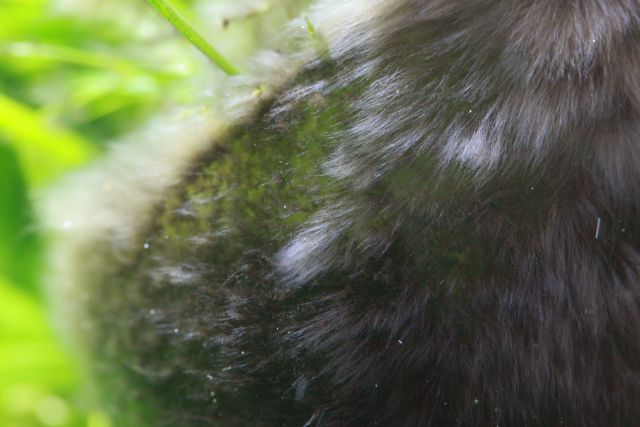In order to get answers to basic questions all around algae in the aquarium, we recommend you read this article first.
Black beard algae (BBA) or brush algae (Audouinella sp., Rhodochorton sp.) belong to the group of red algae, just like staghorn algae. Their natural color is not red, though, but varies from dark green over grey to a deep black. However, if you put these algae in alcohol, they will turn reddish. This is an easy proof that the algae you're dealing with are actually red algae. Beard algae cling stubbornly to the ground they grow on, like technical equipment, the leaf margins of aquatic plants, aquarium decoration or even grains of the substrate. The algae tufts look like a beard or a brush, and that's where the name comes from.
Common causes
Black Beard algae are found in fish tanks as well as in densely planted aquascapes, for different reasons, though. In tanks with a high stock of fish and almost plants or no plants at all, the black color variant is often seen. In these tanks, the reason for their appearance is a high organic water pollution, due to overfeeding in combination with few water changes. In many cases, the algae population in these aquaria grows exorbitantly if lots of muck has build up in the filter and in the substrate. Cleaning the filter and using a gravel cleaner for getting rid of the muck in the substrate ought to help.
Quite frequently, there is no CO2 system on such a tank. It is believed that the content of free carbon dioxide (CO2) in the water plays an important part for the appearance of red algae like beard algae. If there is a CO2 deficiency, these algae can take the carbon they require from hydrogen carbonate, and with much more ease than higher aquatic plants. They can separate the carbon from the hydrogen carbonate ion, thus creating hydroxide ions, which elevate the pH. In this process, the so-called biogenic decalcification takes place, limescale (calcium carbonate) precipitates, which is in turn used by the algae to fortify their cell walls. They become harder and more unattractive to algae eaters.
Especially in fish-only tanks where a lot of food is given - but really for all aquaria, come to think of it - regular maintenance work including a weekly water change are vital. If you slack off with the water changes, unwanted substances can build up in the water. We recommend rather large weekly changes of at least 50% of the tank water.

In aquascapes or planted tanks, a well-balanced nutrient supply is vital for the plants. In planted tanks, you often have beard algae when there is an imbalance of micronutrients (trace elements, especially iron). If you already use an iron fertiliser, you ought to reduce the dosage. Measure the iron content of the water with a water test. It ought to be at around 0.05 to 0.1 mg/l. Of course, carbon (CO2) and macronutrients (NPK) should be added, too. In the following list you can find the target values for the individual nutritional elements:
- A CO2 content of approximately 20-30 mg/l, measurable by a permanent test with test agent
- 10 to 25 mg/l of nitrate (NO3)
- 5 to 10 mg/l of potassium (K)
- 0.1 to 1 mg/l of phosphate (PO4)
- >10 mg/l of magnesium (Mg)
If you have black beard algae in your tank, and the plants show signs of an iron deficiency at the same time (the shoot tips are of a much lighter color than the rest), you might want to consider switching to a less intensely chelated iron fertiliser like for example Aqua Rebell Spezial Flowgrow. Sometimes, adding iron exclusively (without the other trace elements) has been successful. For daily fertilisation we recommend our Aqua Rebell Mikro Spezial Eisen. Only add the standard iron fertiliser with trace elements only once per week, and sparingly.
Control
You have problems with beard algae in your tank? We recommend using Easy Carbo by Easy Life. According to the instructions given by the manufacturer, you should add 1 to 2 ml if the liquid per 50 liters of aquarium water. After a few days, the beard algae should turn whitish or pink. If this has happened, you can stop adding Easy Carbo. The dead algae are eaten by algivores (like for example Amano shrimp and even ramshorn snails) bit by bit. You can find a precise instruction on the use of Easy Carbo here.
Should this treatment not be successful you can try fogging, i. e. you treat the algae locally and in a targeted way with an algicide like Easy Carbo or hydrogen peroxide.